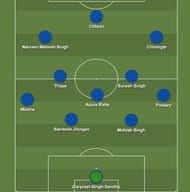After a month’s hiatus, the Indian men’s national team are now gearing up for the crucial 2026 FIFA World Cup qualifiers. Having been grouped with Qatar, Kuwait, and Afghanistan in the second round, the Blue Tigers will kick off their campaign against Kuwait in Kuwait City on November 16. That will be followed by a clash with Qatar at the Kalinga Stadium on November 21.
India will set foot in Round 3 of the qualifiers if they manage to finish in the top two in their group. Igor Stimac and his men certainly have the experience of playing against all three opponents in the group, which could serve as an advantage when they come up against them.
After going on an impressive 11-game unbeaten run this year, India are currently on a losing streak. They suffered defeats in the King’s Cup against Iraq and Lebanon, as well as a 4-2 loss to Malaysia in the Merdeka Tournament.
Stimac has already named a 28-man probable squad for the upcoming games, with the players currently in Dubai for training before their journey to Kuwait. While the squad is well-balanced, the absence of two key players, Anwar Ali and Jeakson Singh, could be significant. Their absence was undoubtedly evident in the match against Malaysia, where defensive vulnerabilities led to a 4-2 loss.
With the Blue Tigers facing difficult opponents in the upcoming month, it will be interesting to see if Stimac changes his system and approach given the absence of his two key players.
On that note, let’s delve into the three ways the Croatian head coach could set his team up against Kuwait and Qatar.
#1 4-2-3-1 system
The 4-2-3-1 formation on paper has been Igor Stimac’s tried and tested approach in the recent past. The players are familiar with this setup, as it aligns with their strengths.
However, the absence of Jeakson Singh creates an opening in the lineup, presenting an opportunity for players like Suresh Singh Wangjam, Apuia Ralte and Rohit Kumar to play in the pivot alongside Anirudh Thapa.
While Stimac has typically favored the Bengaluru FC duo, Apuia’s form for Mumbai City FC will have to be taken into consideration. The 23-year-old midfielder has excelled in a deeper role for his club since Ahmed Jahouh’s departure.
Apuia will seamlessly integrate into the midfield alongside Thapa, offering not only defensive stability but also the ability to progress the ball when he receives possession.
Opting for Apuia over Suresh Singh and Rohit Kumar will certainly improve the team’s overall structure, and will allow the forwards (Sahal, Naorem Mahesh Singh, Chhangte, and Sunil Chhetri) more opportunities to attack their opponents.

#2 4-3-3 system
While Stimac has stuck with the 4-2-3-1 formation, he has also displayed a willingness to play a 4-3-3 system without attacking midfielders in the starting lineup.
With the absence of Jeakson Singh and Anwar Ali, India face a void in midfield and defense, coupled with a loss of ball-playing ability from the back. Additionally, in clashes against Qatar and Kuwait, the Blue Tigers might find themselves in situations where their opponents could dominate possession.
Consequently, Stimac may consider introducing more defensive-minded players in midfield. This shift could provide India with an edge in terms of maintaining a compact structure and winning midfield battles, a factor that could prove to be important against these two opponents.
Suresh Singh and Apuia Ralte are potential candidates to partner with Thapa, potentially relegating Sahal or Naorem Mahesh Singh to the bench. All three players have the potential to fulfill a box-to-box midfield role as they have both energy and attacking prowess, while also contributing defensively.

#3 3-4-2-1 system
The 3-4-2-1 system could be a viable alternative for Stimac, in light of the opponents’ strengths. India have faced challenges away from home in recent years, and with the absence of two key players, the Croatian head coach might lean towards a back-five formation to provide added protection to his defenders.
There was also evidence of India’s struggles against Malaysia when they named an attacking lineup without Anwar Ali and Jeakson Singh. There could well be a repeat of that, as both Mehtab Singh and Sandesh Jhingan were constantly exposed to one-on-one situations when the full-backs advanced higher up the pitch.
Given Poojary and Akash Mishra’s attacking potential, playing three center-backs might well suit India, offering an additional defensive layer for both midfielders and defenders.
In this context, Subhasish Bose’s inclusion as the left-sided center-back holds merit. He has shown his ability to perform in a back three for his club, Mohun Bagan Super Giant.
Furthermore, Mehtab Singh was also comfortable in a back-five setup for Mumbai City FC in the AFC Champions League against Al-Hilal.

While it might be perceived as a defensive approach, the back-five structure enables India to maintain a solid defensive shape while allowing attackers the freedom to exploit counter-attacking opportunities.
